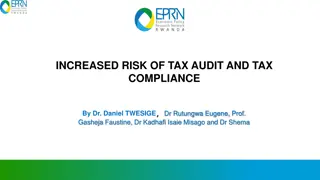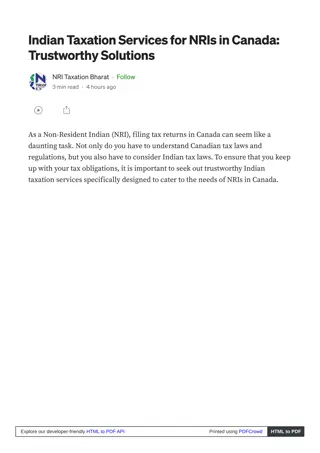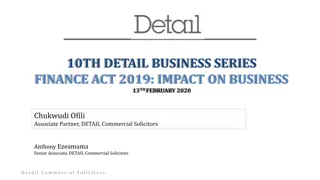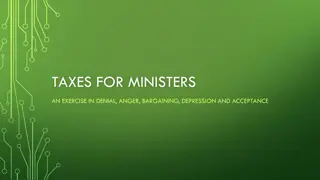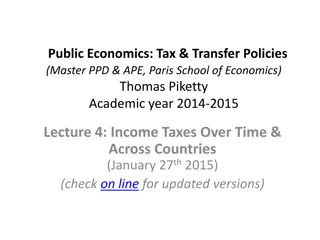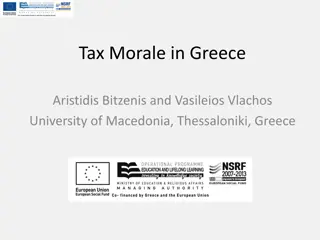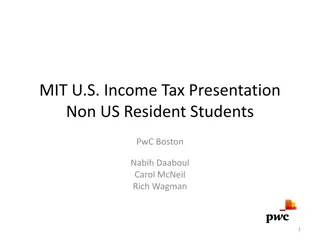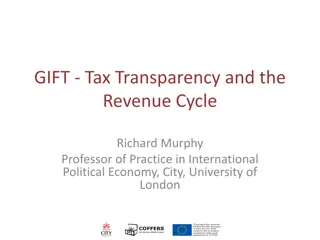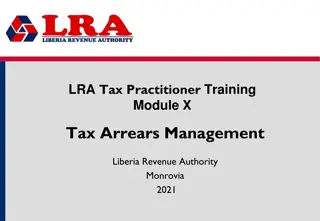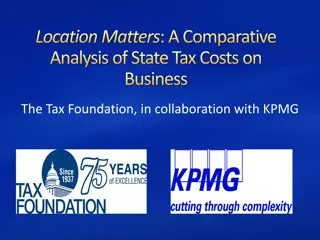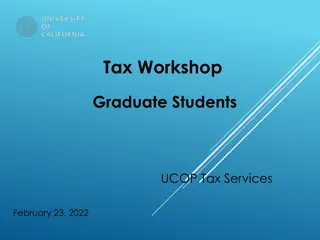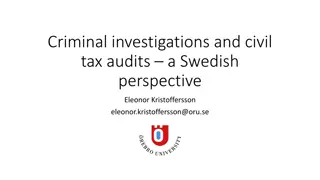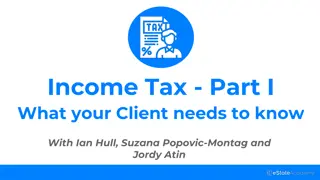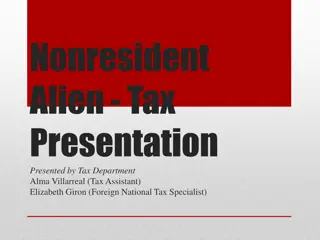
Ireland's Aviation Financing Tax System
Explore why Ireland's tax system is ideal for aviation financing, detailing factors such as pro-business attitudes, regulatory environment, and fiscal considerations. Learn about the significant pool of talent, tax benefits, and structuring options available in Ireland, making it a leading center for aviation finance.
Download Presentation

Please find below an Image/Link to download the presentation.
The content on the website is provided AS IS for your information and personal use only. It may not be sold, licensed, or shared on other websites without obtaining consent from the author. If you encounter any issues during the download, it is possible that the publisher has removed the file from their server.
You are allowed to download the files provided on this website for personal or commercial use, subject to the condition that they are used lawfully. All files are the property of their respective owners.
The content on the website is provided AS IS for your information and personal use only. It may not be sold, licensed, or shared on other websites without obtaining consent from the author.
E N D
Presentation Transcript
2015 The Global Tax Environment The Global Tax Environment - Why Ireland s tax system works for aviation financing - BEPS and the evolving global tax landscape Joe O Mara Joe O Mara KPMG
2015 What makes Ireland the leading centre for aviation finance? 1. People significant pool of experience and talent 2. Pro-business attitude of Irish Government 3. Professional services infrastructure 4. Regulatory environment 5. Geographic location midway between major centres 6. Capetown Convention 7. Fiscal environment
2015 Fiscal environment 1. Irish platform issues 2. International tax considerations 3. Investor taxes
2015 1. Irish platform issues Tax residence Benefits of Irish tax regime Access to tax treaty network Management and control, activities of the Board of Directors Tax depreciation 8 years straight line basis generally leads to cash tax deferral for a number of years Funding / leverage No thin capitalisation, can high leverage Irish company and manage effective tax rate Interest withholding tax and anti-avoidance issues to manage Possible to substantiate a high coupon on subordinated debt (subject to transfer pricing) Cash repatriation Dividend withholding tax exemptions for EU/tax treaty jurisdictions (can look to ultimate owner)
2015 1. Irish platform issues Group relief and tax losses Group relief available on a current year basis 75% relationship required, direct/indirect relationship but through EU/tax treaty jurisdictions Tax losses can be carried forward indefinitely Trading v Section 110 company Same corporate form specific legislative requirements to meet before elect to be Section 110 Tax residence, tax depreciation, interest/dividend withholding tax positions broadly similar 12.5% vs. 25% headline rates Deduction for profit participating interest for Section 110 Change in law risk? Trading more established, Section 110 only in recent years Substance issues can arise for Section 110 from a jurisdictional tax perspective Transfer pricing Requirement for all intra-group arrangements to be documented and at arm s length price (exclusion for S110 and PPLs)
2015 1. Irish platform issues Example of typical structure Funding Holding company / Investor vehicles Operating company (Ireland) Financing company (Treaty country) Service Agreement Subordinated Debt Asset owning companies (Ireland) External Finance Senior Debt
2015 2. International tax issues Withholding taxes The above features of Ireland s tax regime are helpful however of greater importance is Ireland s double tax treaty network Ireland has signed 72 double tax treaties. These treaties tend to favour Irish lessors and many of Ireland s treaties feature uniquely favourable terms with the result that operators in many jurisdictions now insist on leasing from Irish lessors. Transfer taxes Ireland s treaty network protects Irish lessors from income tax and withholding tax on lease rents but also protects Irish lessors from capital gains tax on the sale of leased assets Initiatives being taken by other jurisdictions to enhance their attractiveness as centres for aviation finance e.g. Singapore, Hong Kong and PRC FTZs - a threat to Ireland s standing or a focus on marketing offices?
2015 3. Investor taxes Ireland s tax regime generally facilitates foreign direct investment in aircraft leasing platforms, with generous exemptions from withholding tax available on the payment of dividends and interest to shareholders The absence of thin-capitalisation rules affords investors greater flexibility in structuring investment via equity or debt The extensive aircraft leasing industry in Ireland provides scope to achieve substance to benefit from exemptions from CFC rules e.g. the US, Canada, the UK and Germany etc. Irish tax resident companies are the preferred choice for asset back securitization transactions
2015 Project undertaken by OECD at the behest of G20 There are 15 Actions identified in the plan organised around three main pillars: Base Erosion Profit Shifting 1. The coherence of corporate tax at international level 2. A realignment of taxation and substance 3. Transparency coupled with certainty and predictability An ambitious timeframe of 18-24 months (i.e. by December 2015) was set by the OECD to deliver recommendations on the 15 Actions identified Actions are at various states of completeness with discussions drafts issued across each Action Colossal amount of material already issued Strong political support for real change
2015 BEPS 15 Actions 1 Address the tax challenges of the digital economy 2 Neutralise the effects of hybrid mismatch arrangements 3 Strengthen CFC rules 4 Limit base erosion via interest deductions/other financial payments 5 Counter harmful tax practices more effectively taking into account transparency and substance 6 Prevent treaty abuse 7 Prevent the artificial avoidance of PE status 8 Assure that TP outcomes are in line with value creation: intangibles 9-10 Assure that TP outcomes are in line with value creation: risks and capital, and other high-risk transactions 11 Establish methodologies to collect and analyse data on BEPS and the actions to address it 12 Require taxpayers to disclose their aggressive tax planning arrangements 13 Re-examine TP documentation and Country by Country Reporting 14 Make dispute resolution mechanisms more effective 15 Develop a multilateral instrument
2015 Training materials internal reference only Report on challenges complete; VAT discussion draft Dec 2014, final report Dec 2015 Digital Economy BEPS Roadmap 1 Recommendations complete; guidance expected Sep 2015 Hybrid Mismatches 2 Discussion draft April 2015; best practice finalised Sep 2015 CFCs 3 Discussion draft Dec 2014; best practices due Sept 2015; OECD guidelines Dec 2015 Interest deductions 4 Initial report Sep 2014; modified nexus, Feb 2015; strategy non-OECD members Sept 15, final Dec 2015 5 Harmful tax practices Discussion Draft Nov 2014, consultation Jan 2015, DD 22 May 2015, finalised Sep 2015 6 Treaty abuse Discussion draft Oct 2014, consultation Jan 2015, DD 15 May 2015, finalised Sep 2015 7 Definition of PE Intangibles: Paper 1 finished; DDs on special measures & cost contribution arrangements April 2015; Low-value adding services discussion draft Oct 2014 Hard-to-value intangibles discussion draft 4 June 2015 Risk, recharacterisation, commodity transactions, profit splits discussion drafts Dec 2014 All work finalised by Sep 2015 8 TP-Intangibles 9 Consolidated TP-Risk & Capital 10 TP-High Risk Request for input Aug 2014, discussion draft April 2015, finalised in Sep 2015 11 BEPS data Discussion Draft March 2015, finalised in Sep 2015 12 Mandatory Disclosure February 2015 implementation guidance; final package CbyC implementation measures released 8 June 2015 13 TP-Documentation Discussion draft Dec 2014, finalised in Sep 2015 14 Dispute Resolution Feasibility report complete; draft mandate in Feb 2015 with international conference due 5-6 Nov 2015 15 Multilateral Instrument We are here 2014 2015
2015 2. Hybrids BEPS
2015 Action 7 Preventing the artificial avoidance of PE Status If no PE is created under DTA, then you are generally protected from tax in that jurisdiction on business profits If a PE is created in a foreign jurisdiction, it can lead to the following: : Local tax filing requirements (administrative burden for taxpayer) Payment of tax in a foreign jurisdiction (attribution of profits exercise required and possible leakage) Transfer pricing exercise required in order to adequately attribute profits to local PE Could lead to more disputes with tax authorities over whether a PE exists or not Currently possible to manage PE where conclusion of contracts not undertaken & there is no place of business A wider definition of what constitutes a PE is proposed, seeking a fairer allocation of taxing rights. Proposals materially lower the threshold whereby you could create a PE, including though the material negotiation of contracts. Places greater importance on location and activities of marketing individuals. Likely increase group s compliance burden, increase group s tax cost will depend on level of profit attribution (TP analysis required). May lead to more local service companies being established.
2015 Action 6 Prevent Treaty Abuse Aimed at tightening treaty anti-abuse clauses and identifying tax policy considerations that countries should consider before deciding to enter into a tax treaty Proposed introduction of Limitation on Benefits (LOB) or Principal Purpose Test (PPT) clauses PPT is a general anti-avoidance clause (one of main purposes should not be tax avoidance) LOB looks to substance and ownership tests more difficult for smaller nations to satisfy Could impact groups where not significant substance in their home jurisdiction and could also impact the use of LILO structures for leasing Major uncertainty remains over implementation of proposed changes (unlikely to be adopted universally or guillotined into all existing treaties)
2015 Action 13 Country by Country Reporting CbyC is a new tool for tax authorities Internationally coordinated, government-backed approach to protect individual countries tax bases OECD work is substantially complete, 3 main aims: 1. Provide information for high level TP risk assessment 2. Consider appropriateness of pricing and documentation Provide transparent & clear information for Revenue audit purposes It is a real and substantive change that has been adopted already by some countries Approach is a 3 step process: 3. 1. Master file global orientated document 2. Local file country specific document 3. C-by-C reporting template
2015 Action 13 Country by Country Reporting Who? Revenue > 750m (or equivalent in local currency) Profits, revenues, taxes paid What? Number of employees Details of business activities Within 12 months of financial year end When? UK, US, and Spain apply to accounting periods starting on or after 1 January 2016 Home country tax authority Where? Automatic sharing of information Investigate profit allocation Risk assessment tool Why? Facilitate audit
2015 Action 13 Country by Country Reporting Major business concerns with CbyC Risk of challenge by audit increases Used beyond a transfer pricing risk assessment, i.e., raise transfer pricing adjustments without audit Increased potential for disputes as countries focus on different elements to argue for a greater share of profits Information may enter public domain Cost of compliance Key challenges Past filing positions taken Potential PR matters Multiple stakeholders involved in collating information. Resources and costs are involved A robust narrative to articulate the tax position Finance systems and supporting data
2015 BEPS - What happens next and what will be the ultimate impact OECD to issue its overall Explanatory Statement, together with the 15 reports at the end of September, G20 Leaders to discuss the proposals in November Development of Multi-lateral Instrument (80 participating countries) to commence in November, completion date for recommendations set for end of 2016 Aside from CbyC reporting, impact of proposals remains uncertain political fight expected once proposals finalised. Regardless of BEPS eventual outcomes, changes likely at a domestic level in some jurisdictions already happening in some countries (e.g. Diverted Profits Tax in the UK). Important to keep abreast of proposals as they move to the completion phase and be aware of potential future impact

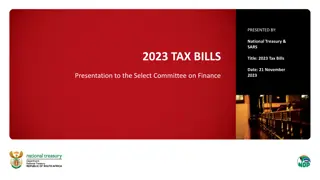

![Town of [Town Name] Real Estate Tax Rates and FY 2024 Budget Summary](/thumb/62211/town-of-town-name-real-estate-tax-rates-and-fy-2024-budget-summary.jpg)
